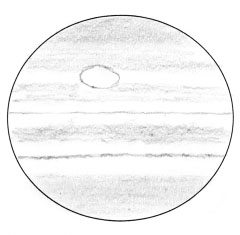 Of course, there are no surface features to be seen when observing Jupiter. Its atmosphere is just too dense to allow visible light to penetrate that far. And even if we could see thousands of miles into the Jovian atmosphere, there is no surface to see. Despite all the visible Jovian phenomena being atmospheric in nature, there are features which have been around long enough to have been named. Unquestionably, the best-known of these is the Great Red Spot. This huge anticyclonic storm has been observed for over 150 years. To give you a sense of its size, nearly three Earths could fit side-by-side across the Great Red Spot, which is visible as a large oval in my sketch. Other visible features include the polar regions, the north temperate belt and both equatorial belts. It's important to learn the standard nomenclature for planetary features. Knowing these names allow you to have meaningful conversations with others about your observations.
Of course, there are no surface features to be seen when observing Jupiter. Its atmosphere is just too dense to allow visible light to penetrate that far. And even if we could see thousands of miles into the Jovian atmosphere, there is no surface to see. Despite all the visible Jovian phenomena being atmospheric in nature, there are features which have been around long enough to have been named. Unquestionably, the best-known of these is the Great Red Spot. This huge anticyclonic storm has been observed for over 150 years. To give you a sense of its size, nearly three Earths could fit side-by-side across the Great Red Spot, which is visible as a large oval in my sketch. Other visible features include the polar regions, the north temperate belt and both equatorial belts. It's important to learn the standard nomenclature for planetary features. Knowing these names allow you to have meaningful conversations with others about your observations.
|
![]()
![]()
